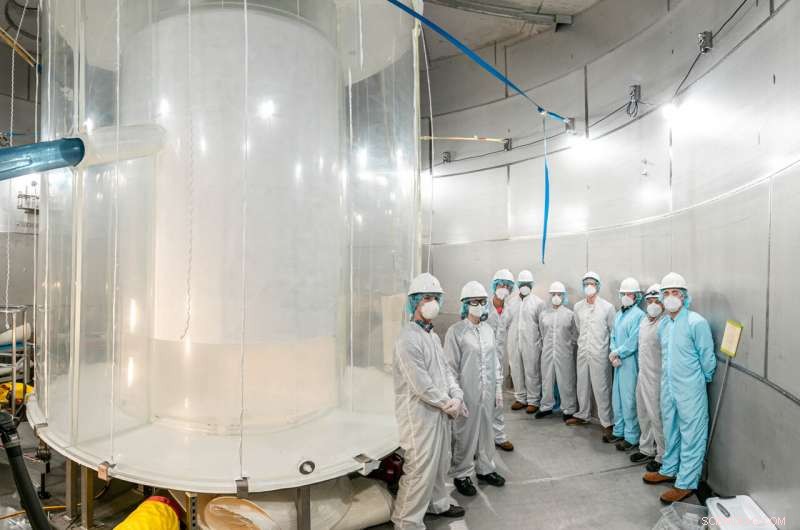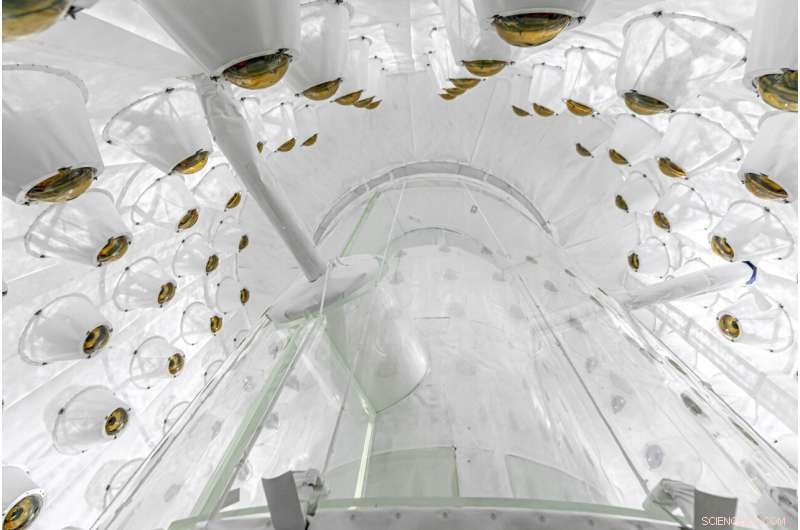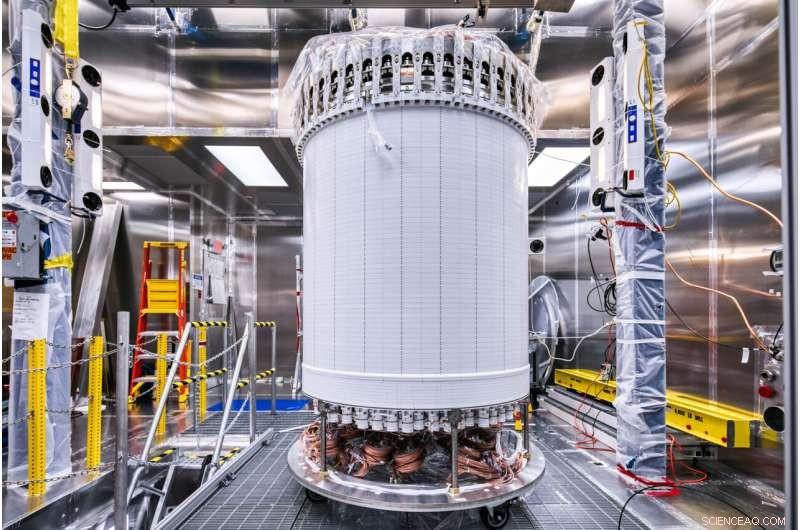
Miembros del equipo LZ en el tanque de agua LZ después de la instalación del detector exterior. Crédito:Matthew Kapust/Instalación subterránea de investigación de Sanford
En las profundidades de las Colinas Negras de Dakota del Sur, en el Centro de Investigación Subterránea de Sanford (SURF), un detector de materia oscura innovador y excepcionalmente sensible, el experimento LUX-ZEPLIN (LZ), dirigido por el Laboratorio Nacional Lawrence Berkeley (Berkeley Lab), ha superado un la fase de verificación de las operaciones de puesta en marcha y entregó los primeros resultados.
El mensaje final de esta exitosa puesta en marcha:"Estamos listos y todo se ve bien", dijo Kevin Lesko, físico senior de Berkeley Lab y ex vocero de LZ. "Es un detector complejo con muchas partes y todas funcionan bien dentro de las expectativas", dijo.
En un artículo publicado hoy en línea en el sitio web del experimento, los investigadores de LZ informan que con la ejecución inicial, LZ ya es el detector de materia oscura más sensible del mundo. El documento aparecerá en el archivo de preimpresión en línea arXiv.org más tarde hoy. El portavoz de LZ, Hugh Lippincott, de la Universidad de California en Santa Bárbara, dijo:"Planeamos recopilar unas 20 veces más datos en los próximos años, por lo que solo estamos comenzando. Hay mucha ciencia por hacer y es muy emocionante". /P>
En realidad, nunca se han detectado partículas de materia oscura, pero tal vez no por mucho más tiempo. La cuenta regresiva puede haber comenzado con los resultados de los primeros 60 "días en vivo" de pruebas de LZ. Estos datos se recopilaron durante un período de tres meses y medio de operaciones iniciales a partir de fines de diciembre. Este fue un período lo suficientemente largo para confirmar que todos los aspectos del detector funcionaban bien.
Invisible, porque no emite, absorbe ni dispersa la luz, la presencia de la materia oscura y la atracción gravitatoria son fundamentales para nuestra comprensión del universo. Por ejemplo, la presencia de materia oscura, estimada en alrededor del 85 por ciento de la masa total del universo, da forma a la forma y el movimiento de las galaxias, y los investigadores la invocan para explicar lo que se sabe sobre la estructura y expansión a gran escala. del universo.

Mirando hacia el detector exterior LZ, utilizado para vetar la radiactividad que puede imitar una señal de materia oscura. Crédito:Matthew Kapust/Instalación subterránea de investigación de Sanford
El corazón del detector de materia oscura LZ se compone de dos tanques de titanio anidados llenos de diez toneladas de xenón líquido muy puro y vistos por dos conjuntos de tubos fotomultiplicadores (PMT) capaces de detectar fuentes de luz débiles. Los tanques de titanio residen en un sistema detector más grande para atrapar partículas que podrían imitar una señal de materia oscura.
"Estoy encantado de ver este detector complejo listo para abordar el problema de larga data de qué está hecha la materia oscura", dijo la directora de la División de Física del Laboratorio de Berkeley, Nathalie Palanque-Delabrouille. "El equipo de LZ ahora tiene en sus manos el instrumento más ambicioso para hacerlo".
Las fases de diseño, fabricación e instalación del detector LZ fueron dirigidas por el director del proyecto de Berkeley Lab, Gil Gilchriese, junto con un equipo internacional de 250 científicos e ingenieros de más de 35 instituciones de EE. UU., Reino Unido, Portugal y Corea del Sur. El gerente de operaciones de LZ es Simon Fiorucci de Berkeley Lab. Together, the collaboration is hoping to use the instrument to record the first direct evidence of dark matter, the so-called missing mass of the cosmos.
Henrique Araújo, from Imperial College London, leads the UK groups and previously the last phase of the UK-based ZEPLIN-III program. He worked very closely with the Berkeley team and other colleagues to integrate the international contributions. "We started out with two groups with different outlooks and ended up with a highly tuned orchestra working seamlessly together to deliver a great experiment," Araújo said.
An underground detector
Tucked away about a mile underground at SURF in Lead, S.D., LZ is designed to capture dark matter in the form of weakly interacting massive particles (WIMPs). The experiment is underground to protect it from cosmic radiation at the surface that could drown out dark matter signals.

(Left) A schematic of the LZ detector. (Right) Illustration of LZ operation—particles interact in liquid xenon, releasing a flash of light and charge that are collected by photomultiplier tube arrays at top and bottom. Credit:Left schematic:LZ collaboration. Right image:LZ/SLAC
Particle collisions in the xenon produce visible scintillation or flashes of light, which are recorded by the PMTs, explained Aaron Manalaysay from Berkeley Lab, who as physics coordinator, led the collaboration's efforts to produce these first physics results. "The collaboration worked well together to calibrate and to understand the detector response," Manalaysay said. "Considering we just turned it on a few months ago and during COVID restrictions, it is impressive we have such significant results already."
The collisions will also knock electrons off xenon atoms, sending them to drift to the top of the chamber under an applied electric field where they produce another flash permitting spatial event reconstruction. The characteristics of the scintillation help determine the types of particles interacting in the xenon.
Mike Headley, executive director of SURF Lab, said, "The entire SURF team congratulates the LZ Collaboration in reaching this major milestone. The LZ team has been a wonderful partner and we're proud to host them at SURF."
Fiorucci said the onsite team deserves special praise at this startup milestone, given that the detector was transported underground late in 2019, just before the onset of the COVID-19 pandemic. He said with travel severely restricted, only a few LZ scientists could make the trip to help on site. The team in South Dakota took excellent care of LZ.
"I'd like to second the praise for the team at SURF and would also like to express gratitude to the large number of people who provided remote support throughout the construction, commissioning and operations of LZ, many of whom worked full time from their home institutions making sure the experiment would be a success and continue to do so now," said Tomasz Biesiadzinski of SLAC, the LZ detector operations manager.

The LZ central detector in the clean room at Sanford Underground Research Facility after assembly, before beginning its journey underground. Credit:Matthew Kapust, Sanford Underground Research Facility
"Lots of subsystems started to come together as we started taking data for detector commissioning, calibrations and science running. Turning on a new experiment is challenging, but we have a great LZ team that worked closely together to get us through the early stages of understanding our detector," said David Woodward from Pennsylvania State University, who coordinates the detector run planning.
Maria Elena Monzani of SLAC, the Deputy Operations Manager for Computing and Software, said, "We had amazing scientists and software developers throughout the collaboration, who tirelessly supported data movement, data processing, and simulations, allowing for a flawless commissioning of the detector. The support of NERSC [National Energy Research Scientific Computing Center] was invaluable."
With confirmation that LZ and its systems are operating successfully, Lesko said, it is time for full-scale observations to begin in hopes that a dark matter particle will collide with a xenon atom in the LZ detector very soon. A major milestone for an underground dark matter search experiment